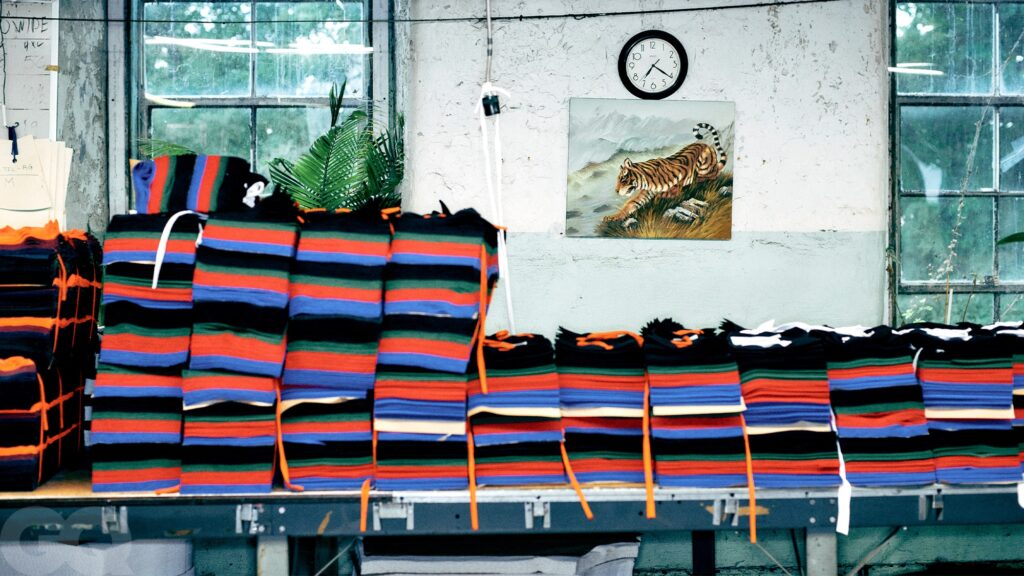You’ve probably never heard of Camber, an apparel company founded in Philadelphia in 1982, though you likely know its garments, or ones that are inspired by them. Its knitwear—sweatshirts and tees, mostly—is distributed globally and often outsells the apparel of brands in New York, London, Toronto, Paris, and Tokyo with 10 times the hype. Camber’s sweatshirts, in particular, have gotten very buzzy lately, but what makes the company remarkable transcends any trend. The company makes sweatshirts like Rolex makes watches, which is to say with a degree of care that borders on the mythic. And it defies all kinds of modern expectations about where and how clothes get made. Camber’s story, which is largely untold, is the story of the greatest sweatshirt ever made. And the only way to fully understand it is to put one on, to feel its heft and quality, though that has become a hard thing to do.
Those sweatshirts—Camber’s coveted Cross-Knit hoodies and crewnecks—are manufactured in an early-20th-century factory in Norristown, Pennsylvania, 20 miles northwest of Philadelphia. The three buildings form a U-shaped white-brick-and-stone colossus that sits on the bank of the Schuylkill River. The 5,000-square-foot Camber factory sits within an 80,000-square-foot industrial complex, but when I visit one Friday morning, I find most of the ground floor empty. A long, dim hallway leads me to a labyrinth of rooms that make up the main office, and there, through several panes of glass, I see Barry Schwartz, Camber’s founder and CEO. Working at a large, municipal-style desk in a tidy office, he appears to be the only person in the entire place. It’s about 9 a.m., and he tells me he’s already been here for hours.
Schwartz, who is 71 but looks 50, is wearing a hunter green thermal-lined zip-up sweatshirt with a collar, no hood (model no. 130) over a navy blue mock neck long-sleeve tee (model no. 306). His beard is meticulously trimmed. He’s got the unhurried, slightly on-edge demeanor of a guy who’s used to getting a lot done before most people’s workdays start. On the wall behind him there’s a framed photo of his Camber-branded Diasio—what he says is a three-quarter-scale replica of a mid-’80s Porsche 962. Among Schwartz’s many hobbies is race car driving. There are no family photos on his desk, because Schwartz is not married and has no children. Across the room from his desk there is a wall of filing cabinets. On top of those cabinets, there is a sprawling stack of clipboards. The clipboards are arranged three, four deep. “Each one represents multiple orders,” Schwartz tells me.
The clipboards keep piling up because Camber’s business is booming. Schwartz runs a wholesale-only operation, meaning these orders are not for individual customers but for brands, shops, and other businesses—his client roster spans a wide spectrum that includes high fashion retailers like Ssense as well as auto-parts manufacturers in Detroit. But in the past year, the typical wait time for a wholesale order to ship from the factory has grown from four to six weeks to something like eight months. Larger orders do not get bumped to the top of the pile. You can’t pay Schwartz extra to expedite your order either. For the most part, he chips away at the clipboards in the exact sequence that the orders arrived, progress governed by the trickle of fabric coming in from his supplier and the moderate pace at which his team, which includes two cutters and about 30 sewers, can assemble the garments.
This system suits Camber for two reasons. The last thing any clothing manufacturer wants to see is the market flooded with products that end up steeply discounted or dumped into outlets because they were overproduced. That’s wasteful and bad for business. But more important, to Schwartz, is that he’s able to operate a morally sound business. “If I overdo it, and I take in too many orders, I’m just burning people,” he tells me. “And they’re not going to like that. I’m not going to like that.”
So Schwartz moves at his own deliberate pace. He oversees every aspect of the business, from fabric sourcing to shipping. He runs one shift. There’s no night crew coming on at the end of the day, and no deputy to step in to run the show when Schwartz leaves. If a customer gets burned, that’s on him. When someone buys a Camber sweatshirt and proudly wears it for 20 or more years, that’s on him too.
As the Schuylkill rushes its way toward the Delaware River, it hurries, with roiling, frothy currents, right by the Camber factory—so close that it feels like it could reach the building. Occasionally it does, in fact, flooding the basement. A year ago, the rains brought on by Hurricane Ida swelled the river to the highest level ever recorded in Norristown and swamped portions of the building where much of Schwartz’s inventory was kept. “We have a tendency to have the river visit us every so often,” Schwartz says. “Last year, it visited the first floor, which had never happened in history.”
trust that you built with your customer. When we decided to start doing more with Camber, we knew that trust would never be betrayed.”
